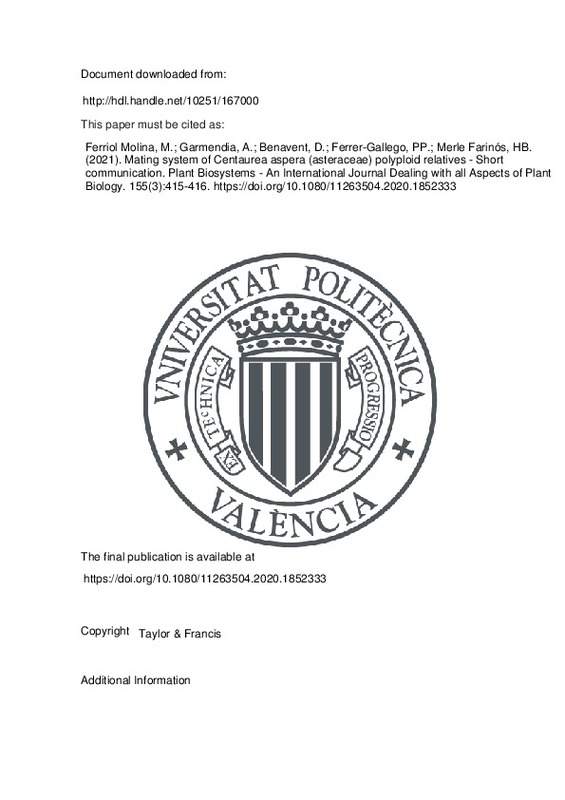Bellanger, S., Guillemin, J.-P., & Darmency, H. (2014). Pseudo-self-compatibility in Centaurea cyanus L. Flora - Morphology, Distribution, Functional Ecology of Plants, 209(7), 325-331. doi:10.1016/j.flora.2014.04.002
Ferriol, M., Garmendia, A., Gonzalez, A., & Merle, H. (2015). Allogamy-Autogamy Switch Enhance Assortative Mating in the Allotetraploid Centaurea seridis L. Coexisting with the Diploid Centaurea aspera L. and Triggers the Asymmetrical Formation of Triploid Hybrids. PLOS ONE, 10(10), e0140465. doi:10.1371/journal.pone.0140465
Ferriol, M., Garmendia, A., Ruiz, J. J., Merle, H., & Boira, H. (2012). Morphological and molecular analysis of natural hybrids between the diploidCentaurea asperaL. and the tetraploidC. seridisL. (Compositae). Plant Biosystems - An International Journal Dealing with all Aspects of Plant Biology, 146(sup1), 86-100. doi:10.1080/11263504.2012.727878
[+]
Bellanger, S., Guillemin, J.-P., & Darmency, H. (2014). Pseudo-self-compatibility in Centaurea cyanus L. Flora - Morphology, Distribution, Functional Ecology of Plants, 209(7), 325-331. doi:10.1016/j.flora.2014.04.002
Ferriol, M., Garmendia, A., Gonzalez, A., & Merle, H. (2015). Allogamy-Autogamy Switch Enhance Assortative Mating in the Allotetraploid Centaurea seridis L. Coexisting with the Diploid Centaurea aspera L. and Triggers the Asymmetrical Formation of Triploid Hybrids. PLOS ONE, 10(10), e0140465. doi:10.1371/journal.pone.0140465
Ferriol, M., Garmendia, A., Ruiz, J. J., Merle, H., & Boira, H. (2012). Morphological and molecular analysis of natural hybrids between the diploidCentaurea asperaL. and the tetraploidC. seridisL. (Compositae). Plant Biosystems - An International Journal Dealing with all Aspects of Plant Biology, 146(sup1), 86-100. doi:10.1080/11263504.2012.727878
Ferriol, M., Merle, H., & Garmendia, A. (2014). Microsatellite evidence for low genetic diversity and reproductive isolation in tetraploidCentaurea seridis(Asteraceae) coexisting with diploidCentaurea asperaand triploid hybrids in contact zones. Botanical Journal of the Linnean Society, 176(1), 82-98. doi:10.1111/boj.12194
Garmendia, A., Ferriol, M., Benavent, D., Ferrer-Gallego, P. P., & Merle, H. (2020). Intra- and Inter-Specific Crosses among Centaurea aspera L. (Asteraceae) Polyploid Relatives—Influences on Distribution and Polyploid Establishment. Plants, 9(9), 1142. doi:10.3390/plants9091142
Garmendia, A., Ferriol, M., Juarez, J., Zając, A., Kałużny, K., & Merle, H. (2015). A rare case of a natural contact zone in Morocco between an autopolyploid and an allopolyploid ofCentaurea asperawith sterile tetraploid hybrids. Plant Biology, 17(3), 746-757. doi:10.1111/plb.12284
Jiao, Y., Wickett, N. J., Ayyampalayam, S., Chanderbali, A. S., Landherr, L., Ralph, P. E., … dePamphilis, C. W. (2011). Ancestral polyploidy in seed plants and angiosperms. Nature, 473(7345), 97-100. doi:10.1038/nature09916
Levin, D. A. (2019). Plant speciation in the age of climate change. Annals of Botany, 124(5), 769-775. doi:10.1093/aob/mcz108
Soltis, D. E., Albert, V. A., Leebens-Mack, J., Bell, C. D., Paterson, A. H., Zheng, C., … Soltis, P. S. (2009). Polyploidy and angiosperm diversification. American Journal of Botany, 96(1), 336-348. doi:10.3732/ajb.0800079
[-]







![[Cerrado]](/themes/UPV/images/candado.png)


